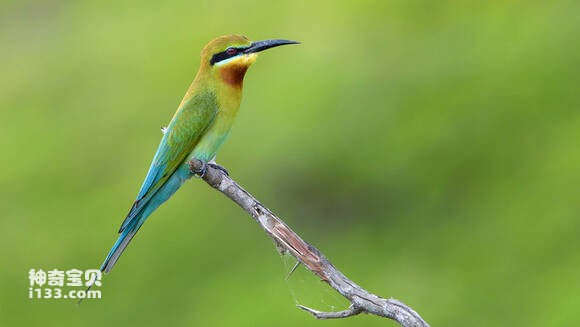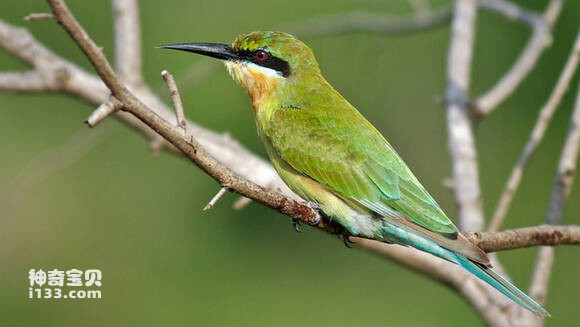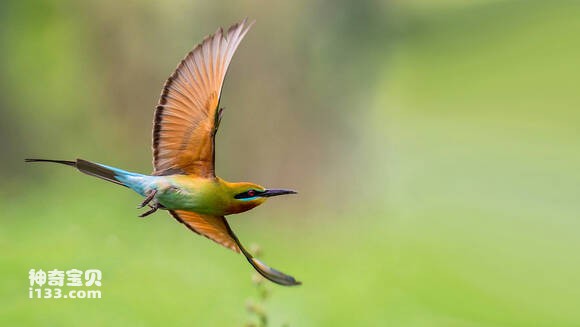Merops philippinus
IUCN
LCBasic Information
Scientific classification
- name:Merops philippinus
- Scientific Name:Red-throated Bee-eater,Merops philippinus,Blue-tailed Bee-eater
- Outline:Climbing birds
- Family:order family genus
Vital signs
- length:25-30cm
- Weight:28-44g
- lifetime:No verification information
Feature
The throat is chestnut red, the eye stripes are black, the wings and back are green, and the tail is blue
Distribution and Habitat
Distributed in Bangladesh, Cambodia, China, India, Indonesia, Lao People's Democratic Republic, Malaysia, Myanmar, Nepal, Pakistan, Papua New Guinea, Philippines, Singapore, Sri Lanka, Thailand, East Timor, Vietnam. Distributed in China (Kinmen, Xiamen Qiqishan, etc.).
Breeds in South Asia, Philippines, Sulawesi and New Guinea. Migrate to Sunda Islands in winter. The nominate subspecies breeds in southeastern Tibet, southern Sichuan, Yunnan, Guangxi and Guangdong in China in summer; it is a resident bird on Hainan Island.
Commonly found in open habitats below 1,200 meters above sea level. Gathers in open areas to hunt. Perched on exposed branches or wires, lazily gliding in circles to find insects.
Appearance
The chestnut-throated bee-eater's tail and waist are blue; its throat is maroon. The front and back of the eyes and the ear feathers are black; the lower part and a narrow eyebrow line are light blue-green; from the forehead to the back and the surface of the wings are bright green; from the top of the head to the back, the grass is green with yellow, and there is a wide black eye stripe from the forehead to the eyes. From the eye to the ear coverts, there is a black eye stripe with a narrow blue stripe above and below it. The waist and upper tail coverts are bright blue, and the tail is blue-green. The central tail feathers are very extended and narrow, and they extend beyond the side tail feathers. The length is far more than twice the length of the tarsometatarsus; the tip protrudes about 38-45 mm, and the protruding tip is black. The surface of the shoulders and wings is grass green, and the upper wing coverts, primary flight feathers and outer secondary flight feathers are br
Details
Blue-tailed Bee-eater, no subspecies.

Blue-tailed Bee-eater is a resident bird in southwestern Yunnan and Hainan Island, China, and a summer migratory bird in other areas. It migrates in April-May and leaves in September-October.
Chestnut-throated bee-eaters usually move in groups of several to dozens of individuals. They can also be seen moving alone or in pairs during the breeding season. They are agile and often catch prey in mid-air while flying. They gather in groups to hunt in open areas. They live on exposed branches or wires, feed on insects, like open fields, dig holes in earth cliffs as nests, and often build nests in large groups, forming spectacular group nests. They prefer to hunt in the air more than other bee-eaters. During the day, from males to females, they often fly over open areas such as farmlands to hunt at night. Sometimes a group of bee-eaters chirp and fly high overhead. They make a mournful trembling sound when flying.

The main food of the Chestnut-throated Bee-eater is the White Butterfly. In addition, dragonflies, cicadas, moths, robber flies, beetles, etc. are also food resources.
The breeding period of the Chestnut-throated Bee-eater is from April to June. Nests are built on steep earthen rock walls near rivers and streams. They dig their own holes for nests, which are tunnel-shaped, about 6-7 cm in diameter and 1-2 meters deep. The end of the hole expands into a nest, which is 15-20 cm in diameter and 8-10 cm high. Each nest lays 5-7 eggs, which are white, oval or round, and 23-27×18-23 mm in size.

There are only a few breeding sites of Chestnut-throated Bee-eaters in Zhangpu, Xiamen and Kinmen in Fujian Province, China. Among them, the breeding population in Kinmen is the largest, with several thousand. Chestnut-throated Bee-eaters are summer migratory birds in Xiamen, which is also said to be the northernmost breeding site. Every year, they migrate to Xiamen in late April and early May to find suitable earth and sand walls as nesting sites, and collectively dig a cave about one meter deep on the earth wall as a nest. Their digging tools are their beaks and claws. Around the end of July, the young birds begin to leave the nest, learn flying and hunting skills, and gradually migrate southward in September to spend the winter.

On May 8, 2003, China Taiwan Post issued a set of 4 special 447 "Conservation Bird Stamps - Chestnut-throated Bee-eater", and also launched a miniature sheet. The background of the miniature sheet is a residential house in Kinmen. It is listed in the 2013 Red List of Endangered Species of the World Conservation Union (IUCN) ver 3.1 - Least Concern (LC).
Listed in the "National List of Terrestrial Wildlife with Important Economic and Scientific Research Value" issued by the State Forestry Administration of China on August 1, 2000.
Listed in the second level of the "National List of Key Protected Wildlife in China".
Protect wild animals and eliminate game.
Maintaining ecological balance is everyone's responsibility!








